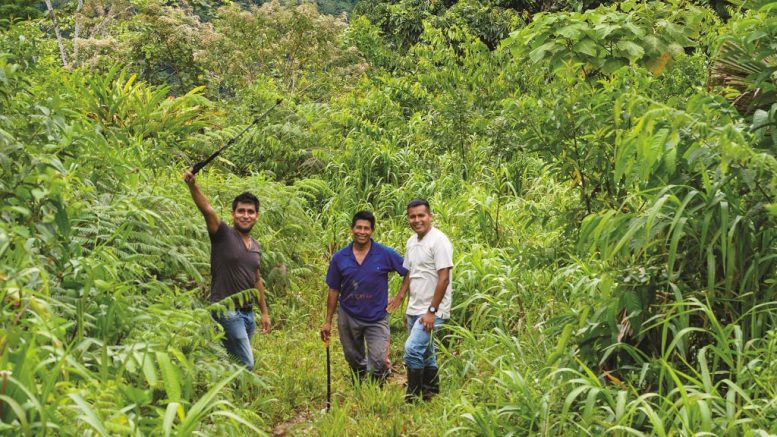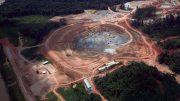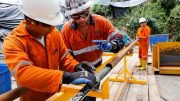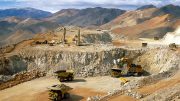South America’s prospective geology, established mining jurisdictions and well-developed infrastructure encourage companies to explore, develop and operate projects in the region. Below, we provide an overview of eight companies with precious and base metal assets on the continent.
Altamira Gold

Trenching at Altamira Gold Corp.’s Cajuiero gold project in the Juruena Mineral Belt of eastern Brazil. Photo Credit: Altamira Gold Corp.
Altamira Gold (TSXV: ALTA) holds over 3,000 sq. km of ground within 11 projects in the Alta Floresta–Juruena gold-copper belt in central Brazil.
The company’s core asset is its Cajueiro project, which has indicated resources of 5.7 million tonnes grading 1.02 grams gold per tonne for a total of 185,000 oz. gold (854,000 of these tonnes at 0.92 gram gold are within weathered oxide material). Additional inferred resources consist of 12.7 million tonnes grading 1.26 grams gold per tonne containing 515,000 gold ounces. This resource category hosts a further 1.7 million tonnes of oxides at 1.12 grams gold.
The resource inventory consists of nine deposits covering 3 sq. km of the 391-sq.-km project. Cajueiro features further soil anomalies that have not yet been drill tested. The company has also identified additional targets at its other properties.
At the end of April, the company entered into a gold forward purchase agreement for gross proceeds of up to US$6 million with Metalstream, a private Malaysian gold streaming company. The proceeds are intended for development of Cajueiro and would be in exchange for 10,000 oz. gold over a five-year period. Construction is expected to start this year ahead of a plant start-up anticipated next year.
In October, Altamira announced the receipt of the first environmental permit for trial mining at Cajueiro, valid for three years and encompassing the southern portion of the resource. By January, it received the first trial mining license for Cajueiro. The company is working towards obtaining trial mining licenses for three additional claims, which cover existing resources.
In addition, the company’s Apiacas land package features seven undrilled targets, whereas the Santa Helena project is a potential porphyry copper site.
Altamira Gold has a $7.4-million market capitalization.
Aurania Resources

Stones from a road found in the Lost Cities–Cutucu Project in southeastern Ecuador. Credit: Aurania Resources/Twitter.
Aurania Resources (TSXV: ARU) is an exploration company focused on its 2,080-sq.-km Lost Cities–Cutucu project in southeastern Ecuador, where historical records suggest two gold-mining centres existed from the 16th and 17th centuries – Sevilla del Oro and Logrono de los Caballeros. In November, field teams found remnants of what the company believes is an old road in the central part of the project that once linked the two centres.
The Cutucu concession covers 95 km along the central part of the Cordillera de Cutucu and is on trend with the established Condor gold-copper belt, host to four operating mines and six additional deposits. Aurania’s approach to exploration includes both conventional analysis of geophysical, geochemical and historical data, as well as a Bayesian inference approach, led by Metron – a scientific consulting company focused on solving problems through advanced mathematics – to identify primary targets of focus.
The company is also using LiDAR surveys (a way of estimating distances through laser reflection measurement that allows imaging of jungle terrain without disturbing vegetation) to detect historical roads and mine workings and to refine exploration targets.
There are currently five types of mineral exploration targets at Cutucu: historic gold mines, epithermal gold, sedimentary-hosted copper-silver, porphyry copper and silver-zinc-lead. Work to date has identified 20 epithermal gold-silver prospects, traced sediment-hosted copper targets over a 23 km strike length, found multiple porphyry copper geophysical targets and identified outcrops of high-grade silver over a 15 km trend, in addition to the two historic mine targets.
Aurania has explored just under 60% of its Ecuador concessions so far. In January, the company applied for mineral concessions in northern Peru that it believes may sit on the same geological trend as its Lost Cities–Cutucu project.
In May, Aurania announced that, based on LiDAR imagery, it has identified a potential road in the central part of the Cutucu project, which will require additional verification in the field. Earlier that month, the company’s use of LiDAR also traced a system of vein features in areas with soil silver enrichment at the Tiria South epithermal gold-silver target. Follow-up work on the ground is required to confirm these structures.
In March, the company closed a $6.5-million private placement, with proceeds intended for ongoing exploration efforts within the Cutucu project. Aurania plans to continue with stream sediment sampling and scout drilling of gold targets as well as with fieldwork to establish continuity of copper-silver mineralization, in addition to ongoing efforts to trace the ancient workings.
Aurania Resources has a $135.1-million market capitalization.
Dynacor Gold Mines

Examining a rock sample at Dynacor Gold Mines’ Tumipampa gold-copper project, 500 km southeast of Lima. Credit: Dynacor Gold Mines.
Dynacor Gold Mines (TSX: DNG) is a dividend-paying company, which processes ore purchased from small-scale and artisanal miners (ASMs) in Peru, where it has been operating for over 20 years. Last year, it produced 80,677 oz. gold and generated a cash gross operating margin of US$208 per gold-equivalent oz. sold.
The company’s business cycle includes the purchase of high-grade ore from ASMs, followed by weighing, assaying and screening at its Veta Dorada 300 tonne per day plant in Peru. Payments to the ASMs are made within 72 hours following receipt of the ore, with a further five to eight days required to process the ore down to a gold dore bar level with 99.5% purity. Dynacor then receives payment for the gold at spot prices from PX Precinox, its Swiss strategic partner.
The Veta Dorada site in southern Peru features a carbon-in-pulp circuit with on-site crushing and milling. A new design of the 300-tonne-per-day operation was opened in 2016 – the site has been set up for potential expansions to 450 tonnes per day and 600 tonnes per day through adding processing lines and ball mills.
Also in Peru, the company holds the Tumipampa and Anta exploration assets. Tumipampa is 60 km south of Abancay and sits within a gold-silver vein epithermal corridor with identified drill targets, whereas Anta is a silver-gold-copper project in the southern part of the country, 72 km west of Nazca, in the centre of a regional epithermal gold-silver belt.
Dynacor is also looking at an expansion project in Senegal. It has completed due diligence on a potential processing plant construction with ASM cooperation in the south-eastern part of the country.
Dynacor Gold Mines has a $64-million market capitalization.
G2 Goldfields
G2 Goldfields (TSXV: GTWO) is an explorer with assets in Guyana and Ontario.
The company’s Aremu-Oko properties in north-central Guyana cover a total of 71.5 square kilometres. Several areas of mineralization have been identified across this holding – the key two are the Aremu mine zone and the Oko deformation zone (ODZ).
The company’s focus is on the 34-sq.-km Oko concession, where there are historical shafts and multiple open-pit workings along a 2 km deformation zone. In April, the company reported drill results from the ODZ, which returned 3 metres of 49 grams gold per tonne as well as 3 metres of 11.5 grams gold. These are from one hole, the deepest to date drilled at Oko, which confirmed continuity of previously drilled areas of high-grade mineralization. Additional step-out intercepts reported in May include 4 metres of 10.8 grams gold, 2 metres of 3 grams gold and 2 metres of 10.5 grams gold.
Drilling at Oko to date has traced gold mineralization over a 750-metre strike, while drilling at the Aremu mine zone, which features a past-producing mine, is planned to start in the third quarter.
G2 also holds the Peters Mine concession within Guyana’s Puruni district, which is the site of the past-producing high-grade Peters mine. The company also has the option to earn a 100% interest in the operational (but undrilled) Jubilee open pit.
In Ontario, G2 holds the 505-sq.-km Sandy Lake project, which covers 60 km of a prospective banded iron formation within the Sandy Lake greenstone belt. This site is 230 km north of Red Lake. The company holds a 100% interest in 445 sq. km of Sandy Lake claims and has the right to earn a 70% interest in a further 60 sq. km of claims. Drill results reported in January from the project include 8 metres of 1.13 grams gold, 3 metres of 1.84 grams gold as well as 61 metres of 0.83 gram gold.
G2 Goldfields has a $66.5-million market capitalization.
Inca One Gold

Consulting geologist John Buckle (second from left) takes a group of investors on a tour of the underground workings at Inca One Resources’ Corizona gold project in Peru. Credit: Inca One Resources.
Inca One Gold (TSXV: IO) holds two gold milling facilities in Peru, which service the country’s small-scale, government-permitted miners: the Chala One and Kori One facilities. The company is now in its sixth year of commercial production and has a combined operating facility of 450 tonnes per day. Under Peruvian law, artisanal miners are required to send their ores to licensed processing sites.
The company’s business model includes deliveries of ore from miners to either the Chala or Kori plants, followed by testing prior to purchase to determine grades and potential recovery levels. Any purchases are made at a discount to spot prices, the material is then stockpiled. The processing stage follows, with carbon harvesting and precious metals concentrate desorption and smelting into a gold dore, which is then sold and exported to Switzerland.
The Chala plant is in the town of Chala in the Arequipa region and is permitted to 100 tonnes per day, with an operating capacity of up to 150 tonnes per day. This facility features in-house labs, as well as desorption and smelting and sits within a high-grade, small-scale mining district.
Kori One, also in the Arequipa region, was purchased from Equinox Gold (TSX: EQX) in 2018 and is permitted up to 350 tonnes per day, but has been operating at an average of 135 tonnes per day since January 2018. Like Chala, this facility is fully integrated for a complete processing cycle through to smelting and, according to the company, has the capacity to produce 50,000 oz. to 75,000 oz. gold per year.
The Chala and Kori plants are situated 47 km apart.
Last year, Chala One processed a total of 22,941 tonnes, producing 12,304 oz. gold, while Kori One processed 29,243 tonnes and generated 12,546 oz. for a total of 24,850 oz. on a company-wide basis.
Inca One Gold has a $12.4-million market capitalization.
Lara Exploration

Core showing quartz veining taken from Lara’s Planalto property. Credit: Lara Exploration.
Lara Exploration (TSXV: LRA) is a company focused on generating precious, base and industrial metal prospects in South America. Lara holds pre-production projects in Chile, Brazil and Peru.
On the joint venture front, it holds interests in three properties in Brazil and Peru.
Lara has a 30% stake in the Planalto project in northern Brazil (70% Capstone Mining [TSX: CS]), which features iron oxide copper-gold (IOCG) mineralization. It has the option to purchase a 100% stake for total cash payments of US$500,000 and has paid US$200,000 to date.
The company also has a 49% interest in the 85-sq.-km Liberdade copper project in northern Brazil’s prolific Carajas district. Chilean state-owned Codelco earned a 51% stake in the property and has elected to increase its interest by another 24% through funding additional exploration. Lara believes that there may be a large IOCG system at this site, based on exploration results received from Codelco in 2013.
Also in Brazil, Lara is earning a 100% interest for US$580,000 in the Damolandia nickel-copper-cobalt project. The 18-sq.-km property presents potential for disseminated and stringer-style sulphide mineralization.
In Peru, Lara also holds a 45% interest (55% Redzone Resources, now Global Battery Metals [TSXV: GBML]) in the Lara copper project, 400 km south of Lima. This 18-sq.-km property features three mineral concessions, with mineralization of a quartz-diorite porphyry traced over an area of 2,000 metres by 500 metres to 800 metres.
In the royalty space, Lara has interests in three projects in Brazil, three in Peru and one in Chile.
One of these is the Celesta copper-gold mine being developed in northern Brazil, within the Curionopolis holding where the company has a 5% interest and a 2% net smelter return royalty (NSR). Lara’s joint-venture partner, privately held Tessarema Resources, can earn a 100% interest in the project by putting the mine into commercial production and paying Lara US$750,000 and the company a 2% NSR.
Peruvian royalties include the 83-sq.-km Corina gold project in southern Peru, nearby Hochschild Mining’s (LSE: HOC) Pallancata and Immaculada mines and Selene mill. Lara optioned the project to Hochschild for US$4.2 million and a 2% NSR royalty.
In the Peruvian base metals space, Lara holds the Puituco and Buenos Aires zinc projects. Puituco, at 4 sq. km, is adjacent to BHP’s (NYSE: BHP; LSE: BHP) claims, whereas the 16 sq. km Buenos Aires project lies 25 km northeast of Puituco.
Lara Exploration has a $27-million market capitalization.
Sierra Metals

Exploration drilling at Sierra Metals’ Yauricocha polymetallic mine in Peru. Credit: Sierra Metals.
Sierra Metals (TSX: SMT; NYSE: SMTS) operates the Yauricocha, Bolivar and Cusi mines in Mexico and Peru, producing silver, copper, lead, zinc and gold.
The company’s largest production contributor is the 82%-owned Yauricocha underground mine in Peru’s Yauyos province. The mine produced 188 million lb. zinc-equivalent last year at all-in sustaining costs (AISCs) of US79¢ per lb. sold and has been operating since 1948. This year, the Yauricocha mill is expected to increase its capacity to 3,600 tonnes per day, up from 3,150 tonnes per day currently.
Ongoing exploration at the operation has traced zones of mineralization that is higher grade and wider than suggested by the resource model. Sierra has also identified additional prospective areas at depth and extending laterally out from the current mine workings, which are contained within a 180-sq.-km land package.
The company’s wholly owned underground Bolivar mine in Mexico’s Chihuahua state generated 27.2 million lb. copper-equivalent last year at AISCs of US$2.86 per lb. sold. The 5,000-tonne-per-day operation sits within a 152-sq.-km land holding, with Sierra exploring and developing additional targets at the property. Beyond Bolivar, the company holds an additional 748 sq. km of ground in the country.
Also in Mexico, the company’s wholly owned Cusi mine in Chihuahua state churned out 1 million oz. silver-equivalent last year at AISCs of US$30.89 per oz. sold. The underground operation, feeding a 1,200-tonne-per-day mill, sits within a 117 sq. km landholding. Sierra’s grounds cover a 12 km-long stretch of the prospective Cusi fault, a 64 km regional structure. The company’s focus at the property is on infill and definition drilling.
In early April, the company announced that, due to the global COVID-19 pandemic, it was suspending its production guidance for the year. Production at the Bolivar and Cusi mines in Mexico was suspended in April in line with a government order to suspend non-essential activities, including mining – this stoppage is expected to continue through to the end of May. At Yauricocha in Peru, a similar suspension was expected through to May 10.
In the first three months of the year, the company produced 84.5 million zinc-equivalent lb. with Yauricocha contributing 54.6 million zinc-equivalent pounds.
Sierra Metals has a $179.9-million market capitalization.
Yamana Gold

Processing facilities at Yamana Gold’s El Penon gold-silver mine in northern Chile. Credit: Yamana Gold
Yamana Gold (TSX: YRI; NYSE: AUY) is a gold and silver producer with operations in Canada and South America. This year it expects to generate 890,000 oz. gold-equivalent on a company-wide basis. (This is a revised guidance number, which incorporates impacts from COVID-19). Updated cost forecasts are pending.
Its largest gold contributor is the Canadian Malartic open-pit mine in Quebec, which is expected to churn out 275,000 oz. gold this year for Yamana. The company has a 50% stake in the asset with Agnico Eagle Mines (TSX, NYSE: AEM), which also has a 50% ownership. The two companies operate the mine through a partnership.
In Chile, Yamana owns the El Penon gold-silver underground mine, which is expected to contribute 162,000 oz. gold and 4 million oz. silver in 2020. Earlier this year, the company was able to increase its gold and silver reserves for the asset, net of mining depletion, and also boost its gold measured and indicated resources by 66%.
The company’s Jacobina complex of underground mines in Brazil is forecast to generate a further 168,000 oz. gold this year. In the first quarter, this asset achieved run rates of 6,500 tonnes per day. In May, Yamana published an update on a further expansion, which would ramp the mine up to 8,500 tonnes per day for annual gold production of 230,000 ounces. Based on an extended mine plan scenario with resource conversion, the asset would have a 14-year mine life with AISCs of US$727 per oz. at a total capital cost of US$57 million. Additional studies and exploration efforts are underway, with a feasibility study expected by the middle of next year.
In Argentina, Yamana’s Cerro Moro complex is forecast to produce 96,000 gold oz. this year and 6.3 million oz. silver. The Minera Florida underground mine in Chile is anticipated to generate 85,000 oz. gold in 2020.
In addition to its producing mineral assets, Yamana holds the Agua Rica copper-gold-silver-molybdenum deposit in Argentina with a feasibility study expected by year-end. The company is evaluating strategic options and partnerships to maximize the value from the asset.
Yamana Gold has a $7-billion market capitalization.





Be the first to comment on "South America Snapshot: Eight companies active in the region"